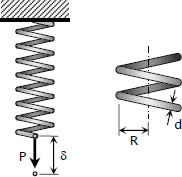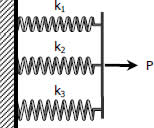Helical Springs | Strength of Materials Review at MATHalino (original) (raw)
When close-coiled helical spring, composed of a wire of round rod of diameter d wound into a helix of mean radius R with n number of turns, is subjected to an axial load P produces the following stresses and elongation:

The maximum shearing stress is the sum of the direct shearing stress τ1 = P/A and the torsional shearing stress τ2 = Tr/J, with T = PR. tau=tau1+tau2\tau = \tau_1 + \tau_2tau=tau_1+tau_2 tau=dfracPpid2/4+dfrac16PRpid3\tau = \dfrac{P}{\pi d^2 / 4} + \dfrac{16PR}{\pi d^3}tau=dfracPpid2/4+dfrac16PRpid3 tau=dfrac16PRpid3left(1+dfracd4Rright)\tau = \dfrac{16PR}{\pi d^3} \left( 1 + \dfrac{d}{4R} \right)tau=dfrac16PRpid3left(1+dfracd4Rright)
This formula neglects the curvature of the spring. This is used for light spring where the ratio d/4_R_ is small.
For heavy springs and considering the curvature of the spring, A.M. Wahl formula a more precise, it is given by: tau=dfrac16PRpid3left(dfrac4m−14m−4+dfrac0.615mright)\tau = \dfrac{16PR}{\pi d^3} \left( \dfrac{4m - 1}{4m - 4} + \dfrac{0.615}{m} \right)tau=dfrac16PRpid3left(dfrac4m−14m−4+dfrac0.615mright)
where m is called the spring index and (4_m_ - 1)/(4_m_ - 4) is the Wahl Factor.
The elongation of the bar is delta=dfrac64PR3nGd4\delta = \dfrac{64PR^3n}{Gd^4}delta=dfrac64PR3nGd4
Notice that the deformation δ is directly proportional to the applied load P. The ratio of P to δ is called the spring constant k and is equal to
k=dfracPdelta=dfracGd464R3n,textN/mmk = \dfrac{P}{\delta} = \dfrac{Gd^4}{64R^3n} \, \text{ N/mm}k=dfracPdelta=dfracGd464R3n,textN/mm
Springs in Series
For two or more springs with spring laid in series, the resulting spring constant k is given by
 1/k=1/k1+1/k2+dots1/k = 1/k_1 + 1/k_2 + \dots1/k=1/k_1+1/k_2+dots
1/k=1/k1+1/k2+dots1/k = 1/k_1 + 1/k_2 + \dots1/k=1/k_1+1/k_2+dots
where _k_1, _k_2,... are the spring constants for different springs.
Springs in Parallel
For two or more springs in parallel, the resulting spring constant is
 k=k1+k2+dotsk = k_1 + k_2 + \dotsk=k_1+k_2+dots
k=k1+k2+dotsk = k_1 + k_2 + \dotsk=k_1+k_2+dots